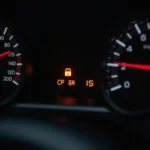Have you heard of the “Pearlescent Effect” in car paint but aren’t sure what it means? Don’t worry, you’re not alone! This term often causes confusion, even among experienced car owners.
Imagine admiring your car in the sun and discovering a shimmering, almost magical shine reminiscent of mother-of-pearl. Sounds fascinating, right? In fact, this effect can be beautiful, but it’s not always intended.
In this article, we delve deeper into the world of the Pearlescent Effect. We’ll explain what causes it, when it can be a sign of paint problems, and how to optimally care for your car paint.
Pearlescent Effect: Feature or Flaw?
The Pearlescent Effect, also known as “Pearl Luster” or “Interference Finish,” is caused by microscopic particles in the clear coat that refract and reflect light in a unique way. This creates shimmering color shifts that vary depending on the viewing angle and light incidence.
Sounds harmless and beautiful at first, but appearances can be deceiving! Sometimes, the Pearlescent Effect is an indicator of paint damage, particularly after improper repairs or strong sun exposure.
“An incorrectly mixed paint spray or improper drying can lead to unwanted pearlescent effects,” explains Dr. Markus Wagner, a paint expert and author of the book “Car Painting: From Theory to Practice”.
Common Causes of Unwanted Pearlescent Effect
- Improper Paint Repairs: A common reason is the use of incorrect paint mixtures or faulty application of the clear coat during repair.
- Strong Sun Exposure: UV rays can damage the clear coat over time and lead to a change in light refraction.
- Lack of Maintenance: Missing or incorrect car care can attack the paint’s protective layer and promote the Pearlescent Effect.
Recognizing the Pearlescent Effect and How to Act
But how do you recognize whether the Pearlescent Effect on your car paint is harmless or a warning sign?
- Observe the Shine: A subtle, even pearl luster can be a sign of a high-quality paint finish. Uneven, patchy, or cloudy luster, however, often indicates paint damage.
- Look for Color Deviations: If, in addition to the Pearlescent Effect, color differences or a “faded” look appear, this is another indication of paint problems.
- Professional Assessment: When in doubt, you should consult a professional paint shop. They can professionally assess the condition of your car paint and recommend the appropriate course of action.
How to Prevent Unwanted Pearlescent Effect
Prevention is the best medicine! With proper car care, you can help ensure your car paint remains beautiful and radiant for a long time:
- Regular Washing: Remove dirt and dust regularly with a gentle car shampoo.
- Paint Sealant: A sealant protects the paint from UV rays, environmental influences, and small scratches.
- Proper Parking Habits: Park your car in the shade whenever possible to reduce exposure to sun radiation.
Further Questions About the Pearlescent Effect
- Can the Pearlescent Effect be removed? Yes, in many cases, the effect can be reduced or removed through professional polishing and paint detailing.
- Is the Pearlescent Effect a sign of rust? Not necessarily. The Pearlescent Effect itself does not cause rust but can be an indication of paint damage that, if untreated, could lead to rust.
Conclusion: Pearlescent Effect – More Shine Than Substance?
The Pearlescent Effect is a fascinating phenomenon that can have both positive and negative sides. While in its intended form it provides an elegant look, it can also be a warning sign for paint problems.
Pay attention to the signs and care for your car paint diligently, and nothing will stand in the way of your vehicle’s radiant appearance!
Do you have questions about car care or need professional support for paint damage repair? Feel free to contact us via the contact form on our website! We’re happy to help you.

